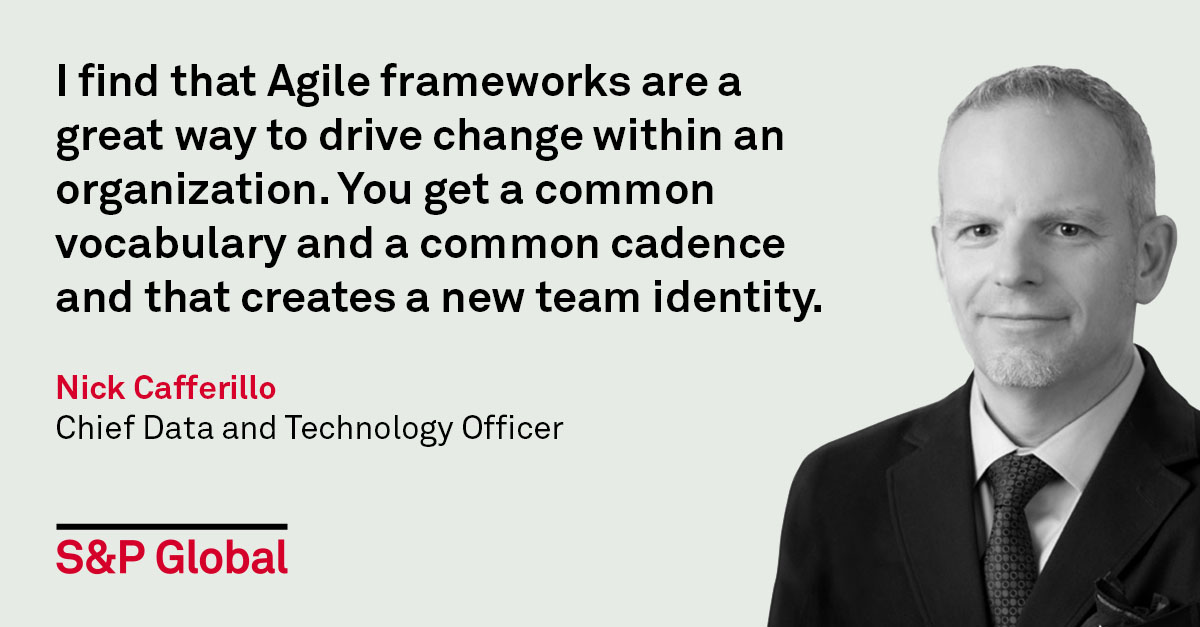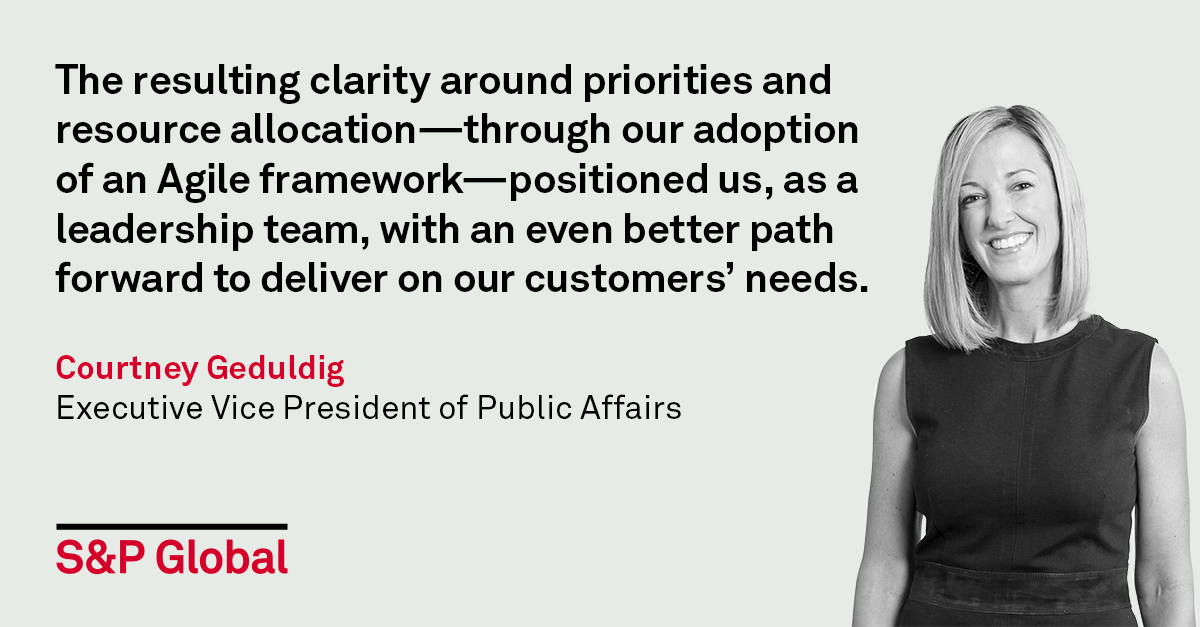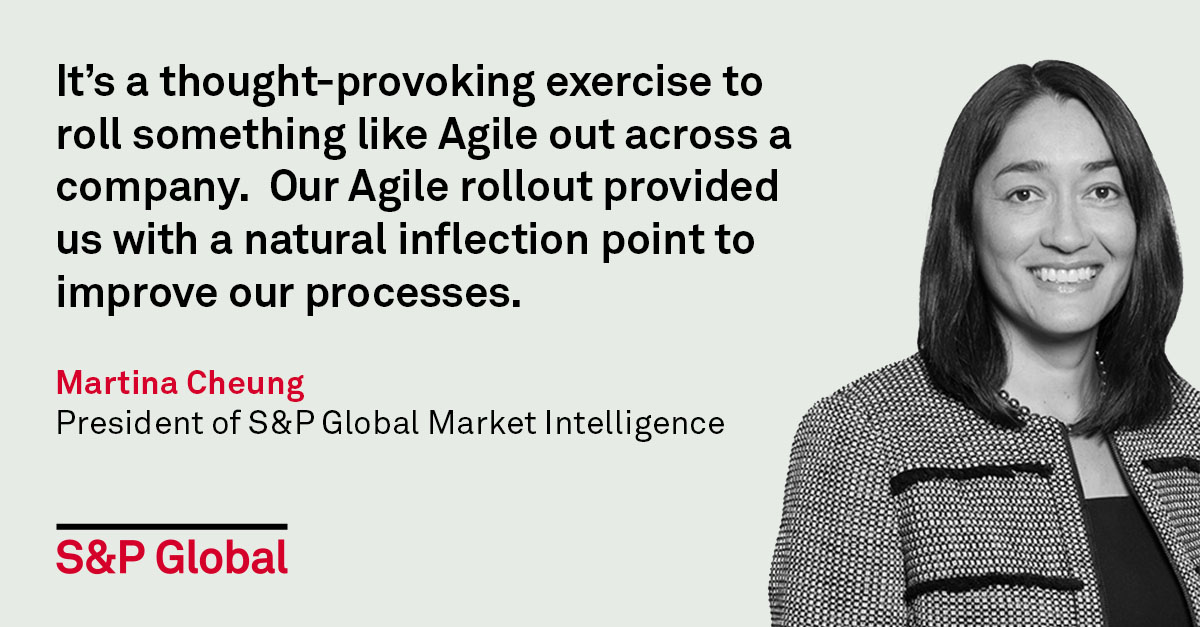Discover more about S&P Global’s offerings
S&P Global adopted Agile Scrum to help our divisions learn to collaborate effectively and work together as one, cohesive company. This adoption, like most big changes, has not been without its challenges. But the lessons learned can help other companies and professionals adopt Agile at scale within their businesses.
Published: October 1, 2018
S&P Global has succeeded in adopting Agile at scale by working through the challenges that arose throughout the adoption with the flexibility and responsiveness that Agile itself embodies. Embodying transparency, responsiveness, and accountability at every level and in every area of the organization was essential to success.
Ryan McClellan was nervous as he walked into the meeting. The merger between SNL Financial – the company where he’d worked for over a decade – and S&P Capital IQ was going well. The cultural fit had proven better than expected. Both companies displayed a certain scrappiness, a shared willingness to tear up old plans and pivot to something new. But Ryan’s boss Nick Cafferillo had assigned him a daunting task. Nick knew that they needed to integrate the two companies’ distinct technology teams into a single, cohesive unit. He wanted Ryan to make that happen.
Culturally, this was going to be hard. There had already been some grumbling about technology integration. Ryan knew there was only one way to get this done. If he could get the entire technology organization to adopt Agile Scrum, he could encourage everyone to see past the old divisions and start working together as a team. Ryan had some experience scaling Agile within an organization and he knew it could break down barriers and get people focused on planning and executing as a team. His plan called for the rolling adoption of a scaled Agile framework over the next two years. It was a tight timeline, but with the right approach to training he thought he could get it done.
Nick Cafferillo quickly flipped through the plan that Ryan had prepared, nearly knocking over the bottle of Diet Coke he always had close at hand. In his faded jeans, Cafferillo cuts an unusual figure among the suited and tailored executives at S&P Global. Perhaps because of these differences, Nick has risen quickly from the COO of the Market Intelligence division to the Chief Data and Technology Officer of the entire company. He had been through his share of mergers in his career and he knew from experience that they didn’t have the luxury of time if this marriage was going to work. Two years was too long. He glanced up at Ryan, “Can you get this done in one year instead?”
“Well, it’s not going to be pretty,” Ryan was stunned. He listened as Nick explained how the initial Agile adoption should be managed iteratively within a limited time period in order to avoid change fatigue and a whiplash effect.
Finally, Nick laid it on the line: “We don’t need pretty – we need Agile.”
Today, S&P Global has over 250 scrum teams operating across the company in both technical and non-technical areas. With 20,000 employees in over 65 locations, the company has adopted Agile at scale in a way few other companies in any industry can claim. By way of comparison, one of S&P Global’s closest competitors recently won an award for standing up 10 scrum teams. Starting from the simple need to integrate technology team after a merger, today the company continues to grow and expand Agile across marketing, human resources and product management, as well as numerous technical teams. This adoption, like most big changes, has not been without its challenges. But the lessons learned can help other companies and professionals adopt Agile at scale within their businesses.

Work Your Plan
Planning should come first. You can’t just say, ‘Let’s go Agile.’” Jackson Griffith, S&P Global Public Affairs Head of Strategy and Operations leans back in his chair and studies a whiteboard covered in diagrams and lists. “Without the PRB and the CPP, we wouldn’t have been able to take this as far as we did. It was crucial for us to define priorities first (through the CPP forum), otherwise we’d be applying Agile principles to the wrong things.”
Like most S&P Global employees involved in the Agile at Scale adoption, Jackson speaks fluent acronym. Over time, what sounds like a slurry of letters gradually resolves into clear definitions everyone on the team understands. The PRB stands for the Project Review Board which is a group of S&P Global employees responsible for deciding which projects and groups are good candidates for central prioritization, having alignment with strategy as well as a solid business case. CPP stands for Centralized Project Prioritization which is the process that allows the project review board to figure out which projects and groups need to get help and resources.
It is these formal meetings and processes that have allowed S&P Global to break out of organizational approaches that date back decades and scale Agile across multiple divisions and functional areas. According to Stan Guzik, Chief Technology Officer of S&P Global’s Platts division, “Most people just want to dive in and start doing things in an Agile way. But if you can’t get key stakeholders to align on priorities, every moment of every day is going to be filled with blockers. Planning is what allows you to work fast and be Agile.”
Acquiring SNL Financial – a company that already had a thriving Agile workflow – jumpstarted the adoption of an Agile framework across S&P Global. It’s often said that you can’t buy innovation. While that may be true, acquiring a core group of employees with Agile experience certainly helped S&P Global adopt Agile at scale. While not all of SNL Financial’s Agile frameworks were adopted, some of their practices caught on across the company. “We had this wonderful thing called the CPP, which brings a single list of initiatives that everybody can march towards. That’s what SNL brought to the table,” Ryan McClellan remembers. “The first thing to do was to integrate those two companies, and one of the pieces of that integration was to bring them to a common Agile framework. Once that took off, there became interest in the other divisions to do something similar.”
“I find that Agile frameworks are a great way to drive change within an organization,” Nick Cafferillo muses while sitting in his Charlottesville, Virginia office. Nick’s elevation from a divisional technology leader to the Chief Data & Technology Officer of a 20,000 global company has coincided with the rapid spread of Agile frameworks throughout the company. “It brings individuals together from different backgrounds and it really forces us all to collaborate. What it ultimately does is build relationships. You get a common vocabulary and a common cadence and that creates a new team identity.”
Scaling an agile framework beyond a few teams brings different planning needs, but also a need for different tools. Kamal Singh has the noun-heavy job title of Head of Agile Tools Product Management in S&P Global’s Program Management Office. According to Singh, “Azure Dev Ops is absolutely vital for organizing a scrum team to get their work done. But to achieve that at scale across hundreds of teams? We would have been lost without Serena.” Singh uses Serena to help prioritize and organize work across multiple divisions. “if you don’t have that enterprise-level planning tool, you risk having individual teams pursuing projects that aren’t aligned to business priorities. Having a Scrum of Scrums helps the planning process, but it’s easier when your tools match your scale.”

Stick to Your Principles, But Know When to Bend
Since the earliest days of S&P Global’s adoption of Agile, Chris LeSauvage has served as the Head of Agile Transformation and Enterprise Program Management. With unfeigned enthusiasm and rounded vowels that betray his Canadian origins, Chris has served as coach, cheerleader, and occasional taskmaster in driving the adoption forward. “The culture of agile wound up really reverberating in positive ways across the entire company. It was just a natural fit. Part of that was not just anchoring Agile and Agile Scrum, but the anchoring of that inside the broader project framework, which starts with the PRB, the CPP, and the team-mapping.”
However, Chris had no illusions that Agile would simply scale itself virally across such a geographically and culturally diverse company. “The tech landscape in S&P Global Platts is completely different from Market Intelligence, which is completely different from Ratings, which is completely different from S&P Dow Jones Indices. Those four divisions have such very different environments, cultures, players, and needs.” The key – LeSauvage is quick to emphasize – is approaching an Agile adoption at scale with flexibility. “You can’t force anything down someone’s throat. You have to take a few key principles and then let the teams figure out how much or how little they want from the framework.”
“It’s called Agile for a reason,” Nick Cafferillo is careful to emphasize. “There are a lot of books written on this stuff. But there’s no formula for how you roll this out. You need to take the principles and best practices and figure out how to use them within your organization. We’re not Google or Facebook or Spotify. We’re different.”
According to Courtney Geduldig, Executive Vice President of Public Affairs, even before the merger “we had invested in the idea of breaking down siloes, achieving rapid growth, and plugging people into the business’ needs. We weren’t Agile yet, but we were already thinking in Agile ways.” This natural inclination towards Agile ways of working has allowed the company to quickly add additional Scrum teams across all four divisions every three to four months.
Aleks Hagy, the senior director of Project Management/Business Analysis at S&P Global Market Intelligence, oversees 35 Scrum teams. “Scrum is a deceptively simple methodology. People look at it and think it is super easy, but it’s not,” she said. “Scrum comes with a lot of psychology pieces. It’s a lot about how a team interacts, how a team feels about each other, it’s about turning those 10 to 14 people towards each other and having them have that conversation. This team-first approach was a natural fit with the culture of the company.”
Using Agile at scale as a cultural unifier gives everyone in the company clarity on what the organization’s priorities are. “You won’t find that in the Agile Scrum textbook. But that’s how we’ve scaled Agile,” Ryan said.

Top Down and Bottom Up
S&P Global is a company with a long past, but a short history. Although the S&P Global brand was introduced in 2016, the four divisions – S&P Global Ratings, S&P Global Market Intelligence, S&P Global Platts, and S&P Dow Jones Indices – date back to the earliest years of the 20th Century and beyond. The adoption of Agile Scrum has helped the divisions learn to collaborate effectively and work together as one, cohesive company. But rolling out the Agile adoption had to be suited to each division’s specific needs and culture.
While S&P Global Market Intelligence, the division that grew out of the merger of SNL Financial and S&P Capital IQ, was the first to adopt Agile at scale, the other divisions have quickly followed suit. Martina Cheung, President of S&P Global Market Intelligence, recalls the initial phases of the Agile adoption saying, “It’s a thought-provoking exercise to roll something like Agile out across a legacy company. People are so focused on the work itself, they often don’t take time to reflect on the process behind the work. The Agile rollout provided us with a natural inflection point to improve our processes.” The adoption was aided by the example of S&P Global’s Operating Committee of top executives. Rather than merely decree the Agile adoption, the committee chose to adopt Agile frameworks like CPP and PRB in their own deliberations.
“Early on, our President and CEO Doug Peterson realized the benefits of Agile for both tech and non tech teams,” said Geduldig. “Some of my Operating Committee peers had used Agile before and we were able to work together to bring everyone to the same level of knowledge to adopt the framework. The resulting clarity around priorities and resource allocation positioned us, as a leadership team, with an even better path forward to deliver on our customers’ needs.” One of the most stubborn obstacles to an Agile at Scale adoption is insufficient buy-in from top executives. The decision by S&P Global’s Operating Committee to “walk the talk” speaks to the level of executive commitment.
Finding the best change-agents in the company who have the bandwidth to engage, participate, and lead by active example can be challenging when senior managers aren’t completely bought in. According to LeSauvage, “The ideal situation is to approach a group and ask, ‘Who wants to drive this change?’” Professionals who are skilled in collaboration and creative problem-solving are the best to bring into these flexible environments. At times, these leaders of change are executives with decades of experience at the company. At other times, the company has hired new people to help.
According to Nick Cafferillo, “This is about people at the end of the day. It’s actually about the relationships between people and how they work. That’s why we didn’t stop with just the technology teams. We realized that agile is a great way to work for marketing, for sales, for every part of our business.”
To avoid resentment and misunderstanding, S&P Global always engages the management team in the training when a new group is adopting Agile Scrum. Griffith claims that “the bottom line is that you need to invest the time to help everyone at the company understand the value.” New behaviors involving development, coaching, testing, and learning need to be taught. Demonstrating to senior leadership that their complete support is crucial to the successful adoption of Agile at scale is a priority for the team at S&P Global. Concrete goals make conversations possible, even if the rollout or Agile textbook isn’t followed perfectly.
Encouraging participation and clearly defining team roles have helped S&P Global to overcome obstacles. “A cornerstone of getting a rollout right is having dedicated people in the roles of Scrum Master and Product Owner – people that understand the role, are accountable for it, and have the time and space to perform in that role,” according to Chris LeSauvage. The model can be adapted to fit groups’ needs. Some teams across S&P Global have re-organized themselves by location, since coordinating a daily Scrum when teams are pollinated internationally across varying time zones can bear counterintuitive outcomes on the Agile process.
The team at S&P Global created a digital dashboard that measured a group’s progress in adoption of the Agile framework based on a range of 35 metrics, evaluating what they determined were winning performance objectives and outcomes. “Nothing incentivizes teams more than seeing that scoreboard,” according to Chris LeSauvage. “Highly accomplished people like to win, so give them a way to see that they’re winning.”
Avanti Paul is exactly the kind of highly accomplished person that Chris LeSauvage is talking about. After a career in consulting and banking, she joined S&P Global Ratings as an analyst. But her passion for finding better ways of working led her to a new position as the Senior Director of Operational Services and the Transformation Lead for the Ratings group. Avanti believes that energy and enthusiasm is crucial to a successful adoption of Agile in large organizations. She hosted a kickoff event for over 600 S&P Global Ratings employees organized into co-located Scrum teams. “We said, ‘What’s your team name going to be? Get a logo for your team!’ They all came up with names like Warriors, Alpha, Hearts and Minds, Game of Scrums. We want them to feel like a team, to have ownership of an application and work as a team regardless of what role they’re in. If we can build that teamwork, that’s what’s going to get us to good, high-quality performance.” As other employees started seeing the team logos and names around the office, a spot in a Scrum team became a desirable commodity, leading to faster, more enthusiastic adoption of Agile workflows.
Ten Takeaways
S&P Global has succeeded in adopting Agile at scale by working through the challenges that arose throughout the adoption with the flexibility and responsiveness that Agile itself embodies. Embodying transparency, responsiveness, and accountability at every level and in every area of the organization was essential to success.
Now, when Ryan reflected on that surprising meeting with Nick Cafferillo, he can see why he insisted on a more rapid rollout. “we’ve taken care to avoid inertia by building the Agile migration around projects, not teams,” he said. “That way new agile teams can forge ahead with a clean slate. You can’t take too long because you’ll wear people out, but you also can’t move too fast and gloss over true adoption.” The process continues to be scrappy, rather than pretty – but the adoption of Agile at scale has proved hugely beneficial to the organization.
Ten Takeaways / What We’ve Learned